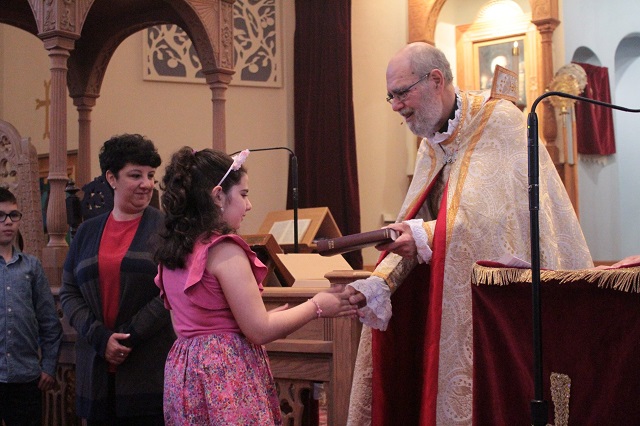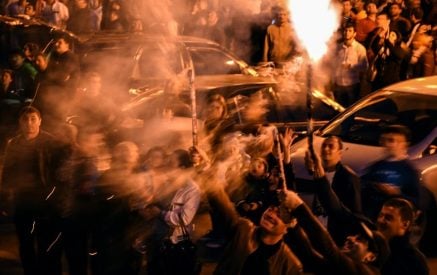The Armenian Weekly. It has often been stated that knowledge is freedom. The Armenians were an enslaved people under Turkish rule for centuries in Western Armenia until the period of enlightenment in the mid to late 19th century brought fresh air into their thinking. The increase of formal education in the homeland and the impact of young Armenians educated in Europe developed an appetite for knowledge and eventually the quest for freedom. The primary source of the Christian Armenian education of children for centuries was the home. This was where the family Bible was the center of knowledge. Village schools either didn’t exist or were considered a supplement to the responsibilities of parents. Eventually the church guided a more formal education system that brought literacy to many. “Sunday schools” as we define them today generally did not exist as religious education was combined with secular topics in the local schools run by the church. The Sunday School concept is essentially a process of the western diaspora. Since there were no village schools in the United States, the church and auxiliary groups opened “Saturday” language schools in the 1920s and eventually “Sunday Schools” for religious instruction either during or after the Soorp Badarak. It was a different approach but was guided by the same value.
This was a workable formula for the baby boomer generation and for portions of the next generation. Thousands of children in the Eastern Diocese and Prelacy were part of these schools that reflected a strong sense of community. There have always been struggles to retain attendance and participation in our diaspora, but signs of decline were evident beginning in the 1980s. Where there were 200 students in large parishes, there are now 100. Some schools in medium or smaller communities began to struggle with securing a critical mass, forcing them to further combine grades, increasing the challenges faced by the dedicated teaching staff. Our leaders failed to address the core issues. Their answer was “well, the world is more secular” or “we can’t tell parents not to have their children participate in sports on Sunday mornings.” The socialization needs in our Armenian families began to emerge as a higher priority than the building of faith through knowledge. It is so much easier to skip church and succumb to the peer pressure.
Of course the church has failed our families also. As intermarriage has become prevalent, the church has not made the necessary adjustments to integrate non-Armenians into the church as knowledgeable, functioning contributors. We all have examples of outstanding non-Armenians in our parishes, but those who left or never connected are the vast majority. In an attempt to avoid controversy and maintain harmony, very few of our priests and lay leaders will directly address the responsibility of parents to focus on their children’s religious and heritage education. They always encourage them to participate but are conflicted as to how to shepherd them to the church. Who can blame them as local leaders when the international and national church has paid little more than lip service to this decades-long decline? We constantly state and restate the problem from a symptom perspective but have been unwilling to truly address the core issues. The questions that beg to be asked are: Do we have the will to succeed or are we paralyzed by fear of conflict? Is the fear of conflict greater than the fear of decline?
To illustrate this issue further, let’s look at the numbers. At face value, the schools seem stable. According to the 2019 Eastern Diocesan report, there were 34 schools in the 2016-2017 school year, declining slightly the following year to 32 and remaining that way in 2018-2019. Enrollment was at 1,596 students in 2016-2017. That number dropped to 1,381 in 2017-2018 and rebounded slightly to 1,403 students in 2018-2019. With our “let’s keep the lights on” mentality in leadership, they probably look at that and say “not bad, but try to do better.” If you are concerned about our future, then you should be alarmed. Why? Currently, we have 44 parishes in the Eastern Diocese. With 32 Sunday Schools, that means there are at least 12 parishes without a Sunday School. How can a parish operate without a Sunday School and expect to complete its mission and have a future? Why isn’t this addressed at the highest level? Why are the priests and lay councils not being held accountable? A few schools shy of one-third of the parishes do not have formal Christian education for the youth. Perhaps they have an ACYOA for teenagers, but at that point, you are receiving what has matriculated without a strong “feeder” school program.
Read also
Another point of interest is that school attendance is at 1,403. That number is about half of what it was a generation ago and the potential pool is much larger today. The problem is that we are not accessing the market. Furthermore these numbers are registered students which is the most optimistic participation statistic available. On any given Sunday, most parishes have 50-percent of those registered attending. The impact of irregular attendance has become more problematic as sports and ambivalence impact participation. I empathize with teachers who dutifully prepare a lesson that starts late due to stragglers and has a fraction of the students. Many of the churches (close to 50-percent) operate by bringing several age groups together, thus complicating the teaching process. Some schools have abandoned classroom teaching because of attendance, and hold general assembly group sessions which have limited impact. Imagine that the diocese on Sunday is educating only 800 to 1000 children across 44 parishes with a compromised process. There is every reason to believe that the Prelacy with its 24 parishes in the eastern region is experiencing a similar decline—parishes with no schools and barely a critical mass of students.
There are many parishes with approximately 100 dues paying members or less (estimated to be 24 of the 44 parishes) that are at this critical stage now. The larger parishes (estimated at 10) have always had the ability to mask the problem with volume and a larger base, but each of them operate far below their peak numbers. Another telling trend: Parishes that have maintained their size of 400 to 600 members have experienced declines in their Sunday school programs. The facts clearly suggest that we are in a crisis and have been for some time. What I find most discouraging has been the lack of national attention and solution-oriented decisions. It is irresponsible for a church to utter the word “future” constantly, yet tolerate the decline of its Sunday Schools.
The Sunday School program usually has its core participants in the age 3 to 13 demographic. Programs at the high school level have been waning except in large parishes due to the aforementioned issues. Our church has a number of programs for teens and college students in the “immersion” category that have been very successful. I am referring to the Datev Institute, St. Nersess, retreats and camps. They tend to comfort the leaders of our church that we are investing in the education of our youth. The problem is that the participants are usually from a pool that emerges from the younger age groups, and if we are declining in those areas, then we are significantly limiting our potential. The output of our declining Sunday School participation and limits on immersion programs lend one to believe that we are preparing for a functional but smaller national church. Investment in that critical age range has been primarily focused on curriculum and to a lesser degree teacher training. I am sorry to say that in the absence of participants, great teachers (and we have many) and lessons are tragically underutilized.
Similar to any institution, our church is a reflection of where we spend our time and money. The decline of our Sunday Schools has been occurring for years, yet parish annual assemblies and diocese level assemblies barely devote time to addressing the root causes. We tend to address them as victims by listing the causes and moving on. The problem is common to both the Prelacy and the Diocese. I attended the Diocesan Assembly for eight years and the Prelacy NRA for another eight. I cannot recall one substantive plenary discussion on the state of our Sunday Schools. This is a formula for failure. We are letting down the church we love and the future generations. Our parish assemblies have become forums to discuss finances and controversies and move on. The diocesan level assemblies are plagued with superficial protocol. We robotically applaud successes with our youth (immersion programs) and ignore the reality of our general decline. We take comfort in seeing a room filled with youth, but fail to realize that it takes many filled rooms to have a future. We have not yet displayed the will to give our youth what we were given by our parents and grandparents. Yes, it’s a different world that requires different methods, but the goal of the church has not changed. Our recovery will begin when we stop denying reality and have the courage to address the root causes. What can and should be done? It’s an important discussion that I will continue next week.




























































